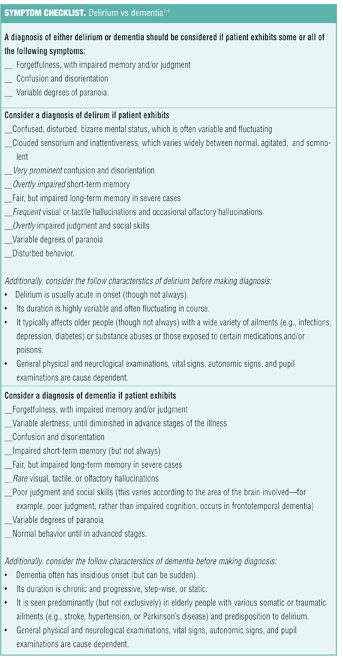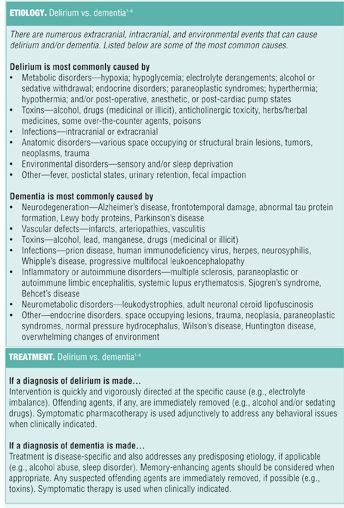 by Steven Lippmann, MD, and Malathi Latha Perugula, MD
by Steven Lippmann, MD, and Malathi Latha Perugula, MD
The authors are from the Department of Psychiatry and Behavioral Science, University of Louisville School of Medicine, Louisville, Kentucky.
Innov Clin Neurosci. 2016;13(9–10):56–57.
This column series compares neurological conditions that pose differential challenges in diagnoses.
Funding: No funding was provided for the preparation of this article.
Financial Disclosures: The authors have no conflicts of interest relevant to the content of this article.
Introduction
Delirium and dementia are two separate mental states that can be characterized by impaired memory and judgement, confusion, disorientation, and variable degrees of paranoia and hallucinations. These similarities can make distinguishing between the two disorders challenging to the inexperienced clinician; however, there are distinct, critical differences that, once recognized, can assist the clinician in making an accurate diagnosis. Here we present a checklist of similarities and differences between delirium and dementia for use as a diagnostic aid.


Summary
In summary, delirium is due to a reversible impairment of cerebral oxidative metabolism and/or various neurotransmitter abnormalities, while in dementia, impaired brain function results from an exogenous insult or an intrinsic process affecting cerebral neurochemistry and/or anatomic damage to the cortex, subcortex, or deeper structures. Delirium is a transient, usually acute and reversible cause of cerebral dysfunction with confusion that manifests clinically with a wide range of neuropsychiatric abnormalities. It can occur at any age, but is more common in elderly people with somatic illnesses or those who have compromised mental statuses. Dementia, on the other hand, is an acquired impairment of executive function in one or more cognitive domains (e.g. memory, language, executive function, judgment, attention, perceptual-motor function, social skills). Dementia represents a significant decline from a previous baseline, interferes with function, is more common in older individuals, and may be persistent.
References
1. Inouye SK, Westendorp RGJ, Saczynski JS. Delirium in elderly people. Lancet. 2014;383(9920):911–922.
2. Mukaetova-Ladinska EB, McKeith IG. Delirium and dementia. Medicine. 2004;32(8):44–47.
3. Hugo J, Ganguli M. Dementia and cognitive impairment: epidemiology, diagnosis, and treatment. Clinic Geriatr Med. 2014;30(3):421-442.
4. Annear MJ, Toye C, McInerney F, et al. What should we know about dementia in the 21st Century? a Delphi consensus study. BMC Geriatrics. 2015;15:5.
5. Lin WL, Chen YF, Wang J. Factors associated with the development of delirium in elderly patients in intensive care units. J Nurs Res. 2015 Dec;23(4):322–329.
6. LaMantia MA, Messina FC, Hobgood CD, Miller DK. Screening for delirium in the emergency department: a systematic review. Ann Emerg Med. 2014;63(5):551–560.





